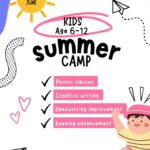Stories have the power to transport us to different worlds, teach us valuable lessons, and help us understand ourselves and others better. In this chapter, you’ll learn how to craft your own engaging stories that will captivate your readers.
Elements of a Good Story
Every memorable story contains these essential elements:
-
Characters
– Main character (protagonist) who drives the story
– Supporting characters who interact with the main character
– Each character should have distinct personality traits and goals
-
Setting
– The time and place where your story happens
– Can be real or imaginary
– Should be described using sensory details (what can be seen, heard, smelled, felt, or tasted)
-
Plot
– Beginning (Introduction)
Introduce main character and setting
Set up the situation
– Middle (Rising Action & Conflict)
Present a problem or challenge
Show how characters try to solve it
Build tension through events
– End (Resolution)
Solve the main problem
Show how characters have changed
Leave readers satisfied
-
Word Limit: 120-150 words
Writing Your Story: Step by Step
Step 1: Planning
Before you start writing, take time to:
– Choose your main character
– Decide on your setting
– Plan your basic plot
– Think about the message or theme
Step 2: Creating Your Opening
Your first paragraph should:
– Hook the reader’s attention
– Introduce your main character
– Establish the setting
– Hint at what’s to come
Example:
Sarah stared at the old brass key in her palm. She’d found it buried in her grandmother’s garden, and something about its intricate design made her heart beat faster. Little did she know this key would unlock more than just a door—it would unlock an adventure she’d never forget.
Step 3: Developing the Story
As you write:
– Use descriptive language
– Include dialogue between characters
– Show characters’ feelings through their actions
– Build tension gradually
– Use transition words to connect ideas
Step 4: Writing the Ending
Your ending should:
– Resolve the main problem
– Tie up loose ends
– Leave readers feeling satisfied
– Consider including a surprise or twist
Tips for Success
– Write what you know and care about
– Show, don’t tell (use actions and dialogue instead of just describing)
– Use strong verbs and specific nouns
– Include sensory details
– Read your story aloud to check how it flows
3 sample short stories written, each between 120-150 words:
- The Lucky Baseball
Tommy clutched his grandfather’s old baseball as he walked onto the field. It was the last inning of the championship game, and his team was down by one run. The worn leather felt familiar in his hands – this ball had been his good luck charm all season.
As he stepped up to bat, Tommy remembered his grandfather’s words: “It’s not about luck, kiddo. It’s about believing in yourself.” The pitcher wound up and threw. Time seemed to slow down as Tommy watched the ball approach. With all his might, he swung the bat.
CRACK! The ball soared high into the afternoon sky. Tommy ran as fast as his legs could carry him, touching first base, then second, then third. The crowd erupted as he slid into home plate, scoring the winning run. His teammates rushed to celebrate, but Tommy just smiled, squeezing his grandfather’s baseball in his pocket.
- The Secret Garden
Maya discovered the hidden gate behind the ivy-covered wall one rainy afternoon. The rusty key she’d found in her attic fit perfectly into the lock. With a deep breath, she pushed the gate open and stepped into a world she never knew existed.
The secret garden was wild and beautiful, with overgrown roses climbing ancient trellises and butterflies dancing between forgotten fountains. As she explored, Maya noticed small wind chimes hanging from tree branches, creating magical melodies in the breeze.
In the center stood an old greenhouse, its glass panels reflecting rainbow patterns on the ground. Inside, she found a dusty journal filled with gardening secrets from long ago. Maya smiled, knowing she’d found something special. This would be her own magical place, where she could escape and dream whenever she needed to.
- The Time Machine Watch
Alex stared at the strange watch his scientist aunt had given him for his birthday. It looked ordinary enough, except for the tiny blue button on its side. “Whatever you do,” she’d warned, “don’t press it unless you really need to.”
Of course, during his boring history test, Alex couldn’t resist. He pressed the button, and suddenly the classroom began to spin. When everything stopped, he found himself in Ancient Egypt! Pyramids rose against the desert sky, and people in traditional clothing walked past him.
Panicking, Alex pressed the button again, returning just in time to finish his test. To his teacher’s surprise, he answered every question about Ancient Egypt perfectly. That evening, as he admired his A+ grade, Alex wondered where – or when – his next adventure would take him.
Common Mistakes to Avoid
– Starting with “Once upon a time”
– Using too many adjectives
– Including unnecessary details
– Rushing the ending
– Making the story too complicated
Checklist for Story Writing
Before submitting your story, check:
– Does your opening grab attention?
– Are your characters interesting?
– Is the setting clear?
– Does the plot make sense?
– Have you included descriptive details?
– Is your ending satisfying?
– Have you proofread for spelling and grammar?
Remember, becoming a good story writer takes practice. Don’t be afraid to experiment with different ideas and styles until you find your voice.

















